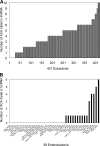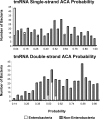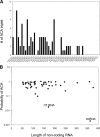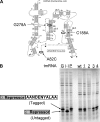Significant bias against the ACA triplet in the tmRNA sequence of Escherichia coli K-12
- PMID: 19633073
- PMCID: PMC2747887
- DOI: 10.1128/JB.00699-09
Significant bias against the ACA triplet in the tmRNA sequence of Escherichia coli K-12
Abstract
The toxin MazF in Escherichia coli cleaves single-stranded RNAs specifically at ACA sequences. MazF overexpression virtually eliminates all cellular mRNAs to completely block protein synthesis. However, protein synthesis can continue on an mRNA that is devoid of ACA triplets. The finding that ribosomal RNAs remain intact in the face of complete translation arrest suggested a purpose for such preservation. We therefore examined the sequences of all transcribed RNAs to determine if there was any statistically significant bias against ACA. While ACA motifs are absent from tmRNA, 4.5S RNA, and seven of the eight 5S rRNAs, statistical analysis revealed that only for tmRNA was the absence nonrandom. The introduction of single-strand ACAs makes tmRNA highly susceptible to MazF cleavage. Furthermore, analysis of tmRNA sequences from 442 bacteria showed that the discrimination against ACA in tmRNAs was seen mostly in enterobacteria. We propose that the unusual bias against ACA in tmRNA may have coevolved with the acquisition of MazF.
Figures







Similar articles
-
A Stress-Induced Bias in the Reading of the Genetic Code in Escherichia coli.mBio. 2016 Nov 15;7(6):e01855-16. doi: 10.1128/mBio.01855-16. mBio. 2016. PMID: 27935840 Free PMC article.
-
MazF activation causes ACA sequence-independent and selective alterations in RNA levels in Escherichia coli.Arch Microbiol. 2020 Jan;202(1):105-114. doi: 10.1007/s00203-019-01726-9. Epub 2019 Sep 4. Arch Microbiol. 2020. PMID: 31485711
-
Insights into the specificity of RNA cleavage by the Escherichia coli MazF toxin.FEBS Lett. 2004 Jun 4;567(2-3):316-20. doi: 10.1016/j.febslet.2004.05.005. FEBS Lett. 2004. PMID: 15178344
-
The discovery of mRNA interferases: implication in bacterial physiology and application to biotechnology.J Cell Physiol. 2006 Dec;209(3):670-6. doi: 10.1002/jcp.20801. J Cell Physiol. 2006. PMID: 17001682 Review.
-
mRNA interferases, sequence-specific endoribonucleases from the toxin-antitoxin systems.Prog Mol Biol Transl Sci. 2009;85:467-500. doi: 10.1016/S0079-6603(08)00812-X. Prog Mol Biol Transl Sci. 2009. PMID: 19215780 Review.
Cited by
-
tRNA is a new target for cleavage by a MazF toxin.Nucleic Acids Res. 2016 Feb 18;44(3):1256-70. doi: 10.1093/nar/gkv1370. Epub 2016 Jan 5. Nucleic Acids Res. 2016. PMID: 26740583 Free PMC article.
-
23S rRNA as an a-Maz-ing new bacterial toxin target.RNA Biol. 2014;11(2):101-5. doi: 10.4161/rna.27949. Epub 2014 Feb 7. RNA Biol. 2014. PMID: 24525465 Free PMC article.
-
In vivo tmRNA protection by SmpB and pre-ribosome binding conformation in solution.RNA. 2014 Oct;20(10):1607-20. doi: 10.1261/rna.045674.114. Epub 2014 Aug 18. RNA. 2014. PMID: 25135523 Free PMC article.
-
Crystallization of the Staphylococcus aureus MazF mRNA interferase.Acta Crystallogr Sect F Struct Biol Cryst Commun. 2011 Mar 1;67(Pt 3):386-9. doi: 10.1107/S1744309111000571. Epub 2011 Feb 25. Acta Crystallogr Sect F Struct Biol Cryst Commun. 2011. PMID: 21393849 Free PMC article.
-
An RNA-seq method for defining endoribonuclease cleavage specificity identifies dual rRNA substrates for toxin MazF-mt3.Nat Commun. 2014 Apr 8;5:3538. doi: 10.1038/ncomms4538. Nat Commun. 2014. PMID: 24709835 Free PMC article.
References
-
- Bjork, G. R. 1996. Stable RNA modification, vol. 2. ASM Press, Washington, DC.
-
- Christensen, S. K., and K. Gerdes. 2003. RelE toxins from bacteria and archaea cleave mRNAs on translating ribosomes, which are rescued by tmRNA. Mol. Microbiol. 48:1389-1400. - PubMed
Publication types
MeSH terms
Substances
LinkOut - more resources
Full Text Sources
Molecular Biology Databases

